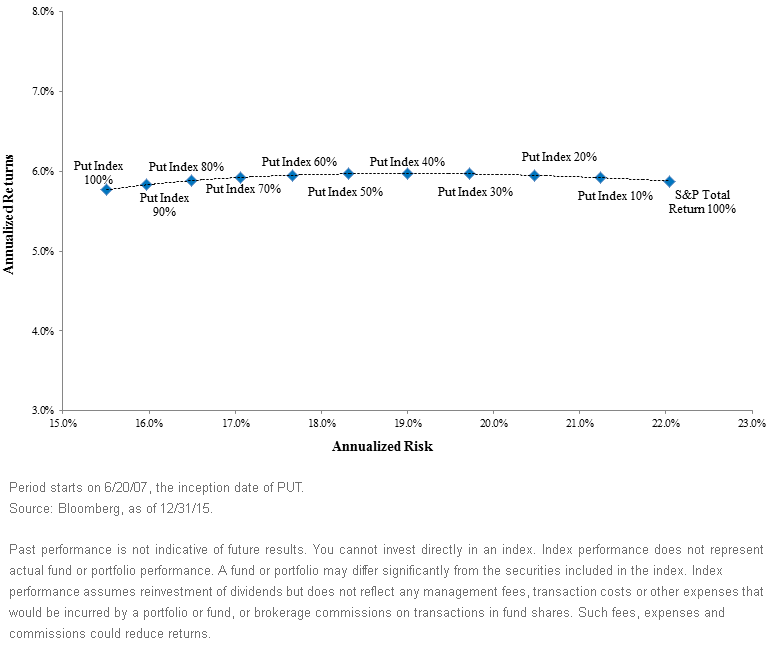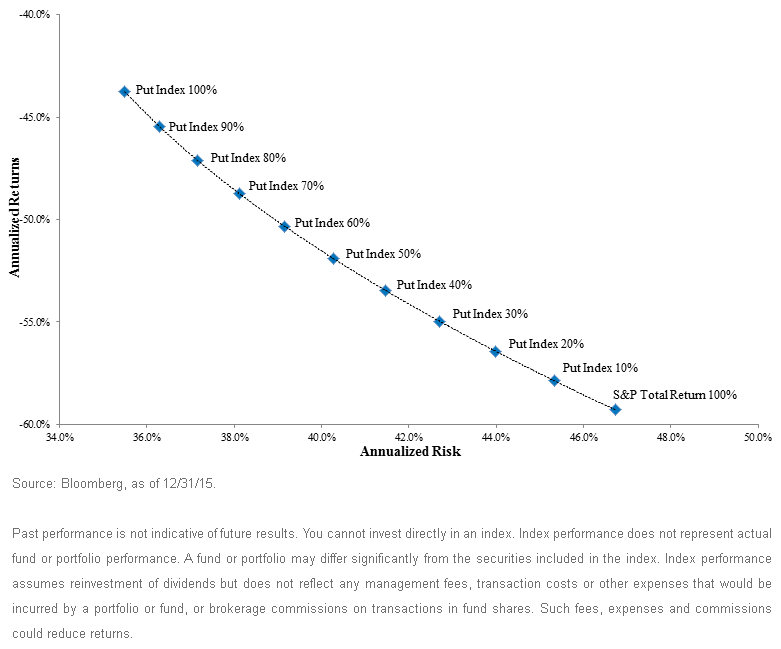
Associate Director, Asset Allocation and Modern Alpha
Markets often go through turbulent phases, and just like a sea captain can never know with 100% certainty when his ship will hit turbulent waters in vast oceans, an investor cannot predict volatile bouts in the markets all the time. Thus, a wise move for investors could be incorporating potential “shock absorbers” in portfolios. This may enable a smoother sail through turbulent markets.
One such shock absorber, we believe, could be the
WisdomTree CBOE S&P 500 PutWrite Strategy Fund (PUTW), which can provide a cushion to portfolio drawdowns during periods of equity corrections. Below, I want to highlight how complementing equity allocations with PUTW can help lower portfolio
volatility,
especially during large market drawdowns.
Refreshing Put Write Strategy Basics
Before we get into the details of implementing PUTW in equity allocations, let’s take a step back to refresh on the strategy mechanics. The Fund tracks the
CBOE S&P 500 PutWrite Index (PUT) and involves selling monthly S&P 500
put options. These options are struck
at the money on their
roll date and can only be exercised on their
maturity date. Also, the PUTW Fund and options being sold are completely cash collateralized with one-month and three-month
Treasury bills. This means PUTW returns are expected to be positively correlated to
S&P 500 Index returns by virtue of the options positions; however, physically the Fund only holds cash in the account from the
option premiums it has sold.
In other words, PUTW could be another way of getting
beta to equity markets.
The question then becomes, how is it different?
The answer is that by selling put options, PUTW collects option premiums, and it is these premiums that act as a potential cushion on the downside. An investor getting beta to equities through PUTW has the same exposure on the downside as an investor buying investment vehicles that track the S&P 500 Index. However, PUTW has collected an upfront premium, and this could make the ride cushioned on the downside.
Lowering Volatility by Blending PUT Write in an Equity Portfolio
Now, the next question arises: How would my portfolio’s risk/return profile change by complementing my equity allocation with a put write strategy?
The chart below conveys how blending the S&P 500 Index with PUT almost linearly decreases the annualized risk in the hypothetical index blend. An investor who complemented an equity allocation with a strategy using put writing may have realized lower volatility throughout this period.
Blending PUT Index with S&P Total Return Index
All Time—06/20/2007–12/31/2015
 The Concern about Big Crashes
The Concern about Big Crashes
Even more interesting is the answer to the next common question: How would this strategy perform during extreme market negative moves?
To answer this, we focused on the crisis period starting in May 2008 and lasting through March 2009. During this time frame, the S&P 500 experienced its biggest drawdowns in recent history, finding its bottom in March 2009 before bouncing back again. Unprepared investors could have lost almost 60% of their equity allocations on an annualized basis during this time.
1
However, following the same chart format as above, the chart below shows that a hypothetical blending of PUT with the S&P 500 Index may have not only helped reduce risk but would have also had lower drawdowns or possibly better returns. This was a partial shock absorber to the market volatility.
Blending PUT Index with S&P Total Return Index
Peak of Financial Crisis—05/19/2008–03/09/2009

Investors who complement their current equity allocations with WisdomTree’s PUTW Fund could maintain a positive beta to equity markets while mitigating overall risk in their allocations. We believe PUTW could provide smoother sailing during tough times in the markets.
Unless otherwise noted, data source is Bloomberg, as of 12/31/15.
1Source: Bloomberg.
Important Risks Related to this Article
|
There are risks associated with investing, including possible loss of principal. The Fund will invest in derivatives, including S&P 500 Index put options (“SPX puts”). Derivative investments can be volatile, and these investments may be less liquid than other securities, and more sensitive to the effects of varied economic conditions. The value of the SPX puts in which the Fund invests is partly based on the volatility used by market participants to price such options (i.e., implied volatility). Increases in the implied volatility of such options will cause their value to increase, which will result in a corresponding increase in the liabilities of the Fund and a decrease in the Fund’s NAV. Options may be subject to volatile swings in price influenced by changes in the value of the underlying instrument. The potential return of the Fund is limited to the amount of option premiums it receives; however, the Fund can potentially lose up to the entire strike price of each option it sells. Due to the investment strategy of the Fund, it may make higher capital gain distributions than other ETFs. Please read the Fund’s prospectus for specific details regarding the Fund’s risk profile.
WisdomTree Funds are distributed by Foreside Fund Services, LLC. Foreside Fund Services, LLC, is not affiliated with CBOE and S&P.
The CBOE S&P 500 PutWrite Index is a product of S&P Dow Jones Indices LLC or its affiliates (“SPDJI”) and CBOE and has been licensed for use by WisdomTree. Standard & Poor’s® and S&P® are registered trademarks of Standard & Poor’s Financial Services LLC (“S&P”); Dow Jones® is a registered trademark of Dow Jones Trademarks Holdings LLC (“Dow Jones”). These trademarks have been licensed for use by SPDJI and sublicensed for certain purposes by WisdomTree. CBOE® is a trademark of the Chicago Board Options Exchange, Incorporated, and has been licensed for use by SPDJI and WisdomTree. The WisdomTree CBOE S&P 500 PutWrite Strategy Fund is not sponsored, endorsed, sold or promoted by SPDJI, Dow Jones, S&P, their respective affiliates or the Chicago Board Options Exchange, Incorporated, and none of such parties make any representation regarding the advisability of investing in such product(s), nor do they have any liability for any errors, omissions or interruptions of the CBOE S&P 500 PutWrite Index.
|
|


 The Concern about Big Crashes
Even more interesting is the answer to the next common question: How would this strategy perform during extreme market negative moves?
To answer this, we focused on the crisis period starting in May 2008 and lasting through March 2009. During this time frame, the S&P 500 experienced its biggest drawdowns in recent history, finding its bottom in March 2009 before bouncing back again. Unprepared investors could have lost almost 60% of their equity allocations on an annualized basis during this time.1
However, following the same chart format as above, the chart below shows that a hypothetical blending of PUT with the S&P 500 Index may have not only helped reduce risk but would have also had lower drawdowns or possibly better returns. This was a partial shock absorber to the market volatility.
Blending PUT Index with S&P Total Return Index
Peak of Financial Crisis—05/19/2008–03/09/2009
The Concern about Big Crashes
Even more interesting is the answer to the next common question: How would this strategy perform during extreme market negative moves?
To answer this, we focused on the crisis period starting in May 2008 and lasting through March 2009. During this time frame, the S&P 500 experienced its biggest drawdowns in recent history, finding its bottom in March 2009 before bouncing back again. Unprepared investors could have lost almost 60% of their equity allocations on an annualized basis during this time.1
However, following the same chart format as above, the chart below shows that a hypothetical blending of PUT with the S&P 500 Index may have not only helped reduce risk but would have also had lower drawdowns or possibly better returns. This was a partial shock absorber to the market volatility.
Blending PUT Index with S&P Total Return Index
Peak of Financial Crisis—05/19/2008–03/09/2009
 Investors who complement their current equity allocations with WisdomTree’s PUTW Fund could maintain a positive beta to equity markets while mitigating overall risk in their allocations. We believe PUTW could provide smoother sailing during tough times in the markets.
Unless otherwise noted, data source is Bloomberg, as of 12/31/15.
1Source: Bloomberg.
Investors who complement their current equity allocations with WisdomTree’s PUTW Fund could maintain a positive beta to equity markets while mitigating overall risk in their allocations. We believe PUTW could provide smoother sailing during tough times in the markets.
Unless otherwise noted, data source is Bloomberg, as of 12/31/15.
1Source: Bloomberg.


